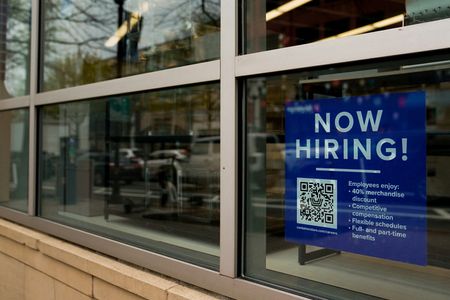By Lucia Mutikani
WASHINGTON (Reuters) – The U.S. services sector slowed in September as new orders fell to a nine-month low, but the pace remained consistent with expectations for solid economic growth in the third quarter.
The survey from the Institute for Supply Management (ISM) on Wednesday also showed services sector inflation remaining elevated last month and employment slowing only gradually. The economy’s resilience, 18 months after the Federal Reserve started raising interest rates to cool demand, suggests that monetary policy could remain tight for some time.
“Resolute messaging from the Fed that rates will remain ‘higher for longer’ may at this point be enough to sustain the downward pressure on economic momentum inflicted by the past year’s actual interest rate increases,” said Kurt Rankin, a senior economist at PNC Financial in Pittsburgh.
The ISM said that its non-manufacturing PMI slipped to 53.6 last month from 54.5 in August. A reading above 50 indicates growth in the services industry, which accounts for more than two-thirds of the economy. The PMI was in line with economists’ expectations and stayed well above the 49.9 level that the ISM says over time indicates an expansion of the overall economy.
Growth estimates for the third quarter were boosted by other data showing motor vehicle sales picking up in September, after hitting a speed bump in August. A strike by United Auto Workers could, however, constrain supply and slow momentum.
Growth forecasts for the third quarter are as high as a 4.9% annualized rate. The economy grew at a 2.1% pace in the April-June quarter.
Thirteen industries reported growth, including retail trade, mining, utilities as well as construction and public administration. Among the five industries reporting a decline were accommodation and food services, and wholesale trade.
Comments from companies were fairly positive as the sector continues to be underpinned by a shift in spending away from goods after phenomenal growth during the COVID-19 pandemic.
Businesses in accommodation and food services said that “prices are coming down across the board for most commodities,” but also noted some lingering supply constraints. Professional, scientific and technical services providers reported that “the fourth quarter is looking better than forecast.”
Retailers said that “business is ramping up in preparation for the holiday season.” But businesses providing management of companies and support services reported that “bank and leasing company volume seems to be falling as credit tightens,” and added that “bankruptcy work is picking up.”
The survey’s measure of new orders received by services businesses dropped to 51.8, the lowest level since December, from 57.5 in August. But order backlogs improved and exports increased.
Stocks on Wall Street were trading higher. The dollar fell against a basket of currencies. U.S. Treasury prices rose.
PRICES REMAIN ELEVATED
Despite the slowdown in new orders, services businesses continued to face higher prices. Twelve services industries reported an increase in prices paid, including utilities, retail and wholesale trade. The four industries reporting a decline were transportation and warehousing, mining, agriculture, forestry, fishing and hunting, and finance and insurance.
A gauge of prices paid by services businesses for inputs was unchanged at 58.9. Some economists view the ISM services prices paid measure as a good predictor of personal consumption expenditures (PCE) inflation. The Fed tracks the PCE price indexes for its 2% inflation target. The annual increase in the PCE price index excluding food and energy fell below 4% in August for the first time in more than two years.
Since March 2022, the U.S. central bank has raised its policy rate by 525 basis points to the current 5.25%-5.50% range. Demand for labor remains strong despite higher borrowing costs. The ISM’s gauge of services sector employment dipped to 53.4 from 54.7 in August, which mostly reflected supply issues.
According the ISM, comments from businesses included “lower due to filling vacated job positions,” and “the labor market remains very competitive” as well as “we have lost employees due to normal attrition and are having issues backfilling these positions.”
That was at odds with the ADP National Employment Report, which showed private payrolls rising by only 89,000 jobs in September, the smallest count since January 2021, after increasing 180,000 in August. September’s gain, which undershot economists’ expectations for 153,000 jobs added, exaggerates the pace of slowdown in the labor market.
The government reported on Tuesday that there were 1.51 job openings for every unemployed person in August and unfilled positions increased by the most in two years. A survey from the Conference Board last week showed consumers’ views of the labor market improved in September.
Economists also cautioned against reading too much into the ADP report, jointly developed with the Stanford Digital Economy Lab, noting it has not been a reliable gauge in trying to predict the private payrolls count in the Labor Department’s Bureau of Labor Statistics’ more comprehensive employment report. The government is scheduled to release September’s report on Friday.
“We do not place much weight on the ADP miss because of ADP’s negative correlation with BLS private payrolls since the introduction of the new methodology and because the September weakness was driven by large firms, whereas the ADP sample is skewed toward smaller firms,” economists at Goldman Sachs said.
Large corporations shed 83,000 jobs, while small businesses added 95,000 positions and medium-sized enterprises’ payrolls increased by 72,000.
According to a Reuters survey of economists, the BLS is expected to report that private payrolls increased by 160,000 jobs in September. Including government employment, total nonfarm payrolls are forecast to have risen by 170,000 jobs last month after increasing by 187,000 in August.
(Reporting by Lucia Mutikani; Editing by Paul Simao, Andrea Ricci and Will Dunham)


